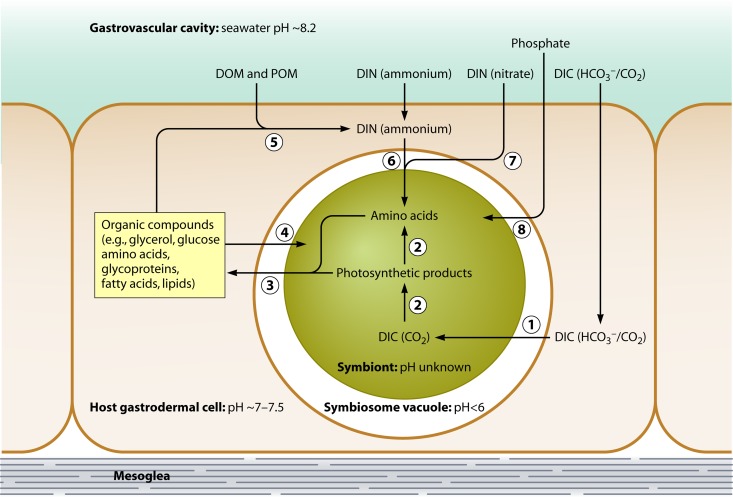Fig 5.
Schematic summary of nutritional interactions in the cnidarian-dinoflagellate symbiosis. 1, dissolved inorganic carbon (DIC) uptake. DIC is acquired either as bicarbonate (HCO3−) from the surrounding seawater or as CO2 from the seawater or host metabolism/calcification. In the case of HCO3−, it must be converted to CO2 prior to photosynthesis by the dinoflagellate symbiont. 2, photosynthesis. CO2 is photosynthetically fixed through the Calvin-Benson cycle (i.e., the C3 pathway), with the dinoflagellate ultimately synthesizing a range of organic compounds, including amino acids. 3, translocation. A portion of the photosynthetic products are translocated to the host cell. 4, reverse translocation. Organic compounds are likely translocated from the host to the symbiont; these compounds could arise from host metabolism or be in the same forms as those originally translocated by the symbiont. 5, host metabolism. Translocated compounds are used, alongside dissolved organic matter (DOM) and particulate organic matter (POM) taken up from seawater, to support host metabolism. The catabolism of nitrogenous compounds ultimately leads to the generation of ammonium waste that can be assimilated by the symbiont. 6, ammonium assimilation. Excretory and seawater ammonium can be assimilated by both the host cell (pathway not shown) and the symbiont, with translocated organic compounds providing carbon skeletons necessary for host assimilation. The assimilation of excretory ammonium back into amino acids by the dinoflagellate symbiont completes the process of “nitrogen recycling” by the symbiosis. 7, nitrate assimilation. Nitrate is taken up from the seawater, but only the symbiont can convert it to ammonium for subsequent assimilation into amino acids. 8, phosphate assimilation. Phosphate is likewise taken up from seawater and can be assimilated by the dinoflagellate symbiont. Note that uptake of nutrients can also occur from the ambient seawater via the epidermis (not illustrated), but for simplicity these pathways are not shown.

